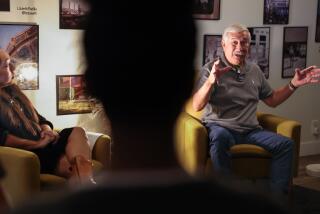Harold Williams dies at 90; architect designed Compton City Hall
When Compton hired architect Harold Williams to design a new City Hall in 1968, it was anything but a smooth sail.
Over the next several years, the project went through three mayors, eight city managers and 10 council members. Each regime offered a different vision for a structure to serve a community that, in just a few decades, had gone from being almost exclusively white to being predominantly African American.
But Williams bird-dogged his clients because such jobs were rare for black architects like him and he was determined “to bring to that community quality architecture,” he recalled in a 1993 oral history. “Because I feel that all people deserve quality architecture.”
Completed in 1976, the two-story Late Modern building remains the architect’s most enduring legacy.
Williams died June 21 of acute respiratory distress syndrome. He was 90.
Harold Louis Williams was born Aug. 4, 1924, in Flemingsburg, Ky., and grew up in Cincinnati, where his father worked as a railroad station baggage handler. Both of his parents were musicians — his father played violin and his mother, piano — and operated a drama club for children.
Early on, Williams displayed artistic abilities, and his interest in architecture grew out of childhood experiences. His father introduced him to a man designing a church. And the minister of the church the family attended, Mt. Zion Colored Methodist Episcopal Church, told him about Paul R. Williams, an African American architect (no relation) who was making a name for himself designing homes for celebrities in Los Angeles.
After graduating from high school in 1942, Williams was drafted into the U.S. Navy. He was denied the chance to become an aviator because he was black, said his wife, Betty. Instead, he served as a radio operator on a submarine chaser in the Pacific.
In 1944, while on leave in Los Angeles, he met Paul Williams, and the two struck up a friendship that influenced the younger man’s decision to practice architecture.
After graduating from Miami University in Ohio, where he was the architecture school’s only black student, he became a draftsman at a Cleveland architecture firm. He also met Betty Smith, whom he married in 1954.
The next year, they moved to Los Angeles, where Williams went to work for his mentor at Paul R. Williams & Associates, serving as a draftsman on homes for Frank Sinatra and other prestigious clients. In 1958, he became the ninth African American architect to be licensed in California.
Eager to create buildings that served the public, Williams formed a firm with two other architects and began designing schools and housing developments. But his most significant commission was Compton City Hall and Civic Center, which included a high-rise county court building.
The project featured a soaring memorial to the Rev. Martin Luther King Jr., on which Williams collaborated with sculptor Gerald Gladstone. The circular work, composed of white panels rising up at varying angles, evokes a mountain, to reflect King’s statement that he had “been to the mountaintop.”
The City Hall building itself is clad largely in floor-to-ceiling glass and dominated by massive vertical concrete fins that span the length of the structure and act as sun shades.
The main entrances are capped by concrete canopies that, according to a Los Angeles Conservancy description, “provide a real sense of occasion to entering the government facility.”
The building represented a new civic identity for the vastly changed community.
“Williams poured his soul into the design,” said Robert Chattel, a preservation architect whose firm completed an award-winning window-replacement project at the building. “It should long stand as testament to an important period in Compton’s history and the remarkable contributions of Williams to beautify the city.”
As part of that project, Chattel’s firm identified Compton City Hall as being eligible for listing in the National Register of Historic Places, a finding that resulted in its automatic listing in the California Register of Historical Resources.
Williams, who went on to establish his own firm, also designed the South Central Los Angeles Multiservice and Child Development Center, the State Office Building in Van Nuys and the King Drew Medical Magnet High School.
After the 1965 Watts riots, Williams served as chairman of the Committee for Simon Rodia’s Towers in Watts, engaging neighbors to help preserve the landmark; he also spearheaded construction of the Watts Towers Art Center. In 1994, he was named a fellow of the American Institute of Architects. He was a founder of the National Organization of Minority Architects.
“Getting African American architects opportunities was one of his missions,” his wife said.
With his white hair and stylish attire (often a black-and-white houndstooth sport coat over a white turtleneck), Williams became “a role model in how to carry yourself professionally and not let people roll over you,” said Roland Wiley, a Los Angeles architect.
“Harold was to me the most vocal of his generation about the lack of opportunities for black architects,” Wiley said.
Williams’ health began deteriorating in the early 2000s. He had a foot amputated because of complications from diabetes, but he and his wife continued to travel to Europe and to enjoy cruises with jazz performers.
In addition to Betty, a retired nursing professor and co-founder of the National Black Nurses Assn., Williams is survived by several nieces and nephews. He had no children.
Twitter: @MarthaGroves
More to Read
Start your day right
Sign up for Essential California for the L.A. Times biggest news, features and recommendations in your inbox six days a week.
You may occasionally receive promotional content from the Los Angeles Times.







